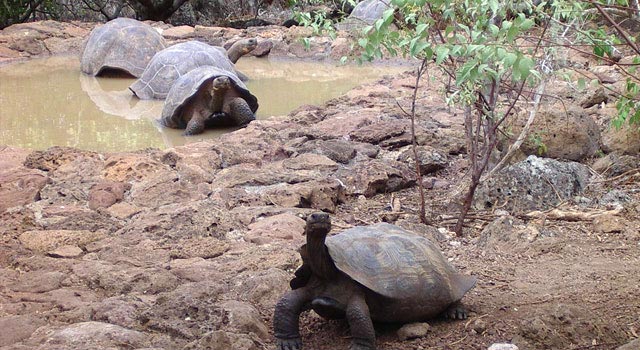Galap. Cerro Colorado :: San Cristóbal Island

It is located in the South East of San Cristobal, to 22.4 km from Port Baquerizo Moreno. Access is by road, the bus ride lasts approximately 40 minutes.
It is located in the vicinity of Cerro Colorado, from which it derives its name, which is one of the few places where you can see Calandrinia galapagosa, a plant endemic to San Cristobal in danger of extinction.
This Galapaguera has been built to improve the status of the population of the island tortoises, Geochelone chatamensis, in an environment with conditions similar to their natural state and thus promote the development of tourism in San Cristobal.
The infrastructure has been integrated into a large corral of 1415m2 and includes: a visitors' center (including an interpretation center, conference room, gift shop, food bar, bathrooms and administration office), a breeding center (includes an herpetology lab and growing pens), interpretive trails and two houses.
Galapagos Islands Tours Galapagos Islands Cruises Galapagos Islands Information
In San Cristóbal there were two populations of tortoises, one located in the Northeast, currently consisting of approximately 1,400 individuals and where the first specimens transferred to Cerro Colorado. The other was south of the island (in an area adjacent to the Cerro Colorado Galapaguera); it became extinct due to extraction by whalers in past centuries.
The natural population of tortoises from San Cristóbal (north of the island) is seriously threatened by introduced animals (mainly wild goats, rats and cats), which to date has been impossible to eradicate despite the continuing efforts in this direction.
![]()
The San Cristóbal tortoises are one of the 11 populations of Galapagos tortoises. They mate once a year and females lay between 12 and 16 eggs. These are picked up immediately by park rangers and put in a dark box for 30 days, after which they are incubated (24°C males and females at 28°C) for a period of 90 to 110 days. Subsequently, the hatchlings are transferred to the growing pens where they remain for a period of two years till they are finally transported to their natural habitat (northeast of San Cristóbal).
In the visitors center, the natural history of the giant tortoises of this island (Geochelone chatamensis) is explained, and the relationship and differences between tortoises of San Cristóbal and the other tortoises in the archipelago, in terms of origin and evolution. Furthermore the current threat of the giant tortoise of San Cristobal is explained and why this area is needed to ensure long-term survival.
Along the trail you can see different species of native and endemic plants of Galapagos: cat's claw (Zanthoxylum Fagara), Manzanillo (Hippomane mancinella) matazarno (Piscidia carthagenensis), romerillo (Macraea laricifolia), lechoso (Scalesia pedunculata) Galapagos croton or chala (Croton scouleri), acacia (Acacia sp.) and Galapagos guaya or guayabillo (Psidium galapageium). Also associated with these plants you can see birds like the San Cristobal Mockingbird (Nesomimus melanotis), Yellow Warbler (Dendroica petechia), Small ground finch (Geospiza fuliginosa), small tree finch (Camarhynchus parvulus) and Galapagos flycatcher (Myiarchus magnirostris).
![]()
Galapagos Islands Tours Galapagos Islands Cruises Galapagos Islands Information
Special Indications
-
The paths cover a distance of 900m, easily passable and combined with wooden walkways and stairs, with many points of information in Spanish and English.
-
During the visit should take special care not to touch or eat manzanillo (Hippomanes mancinella) fruits, a toxic plant predominant in this place.
- We recommend visiting the beach at Puerto Chino and El Mirador de Cerro Colorado in which there is one of the largest populations of Calandrinia galapagosa.

